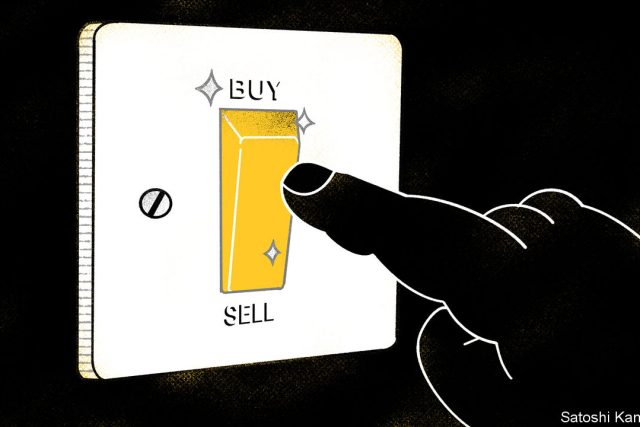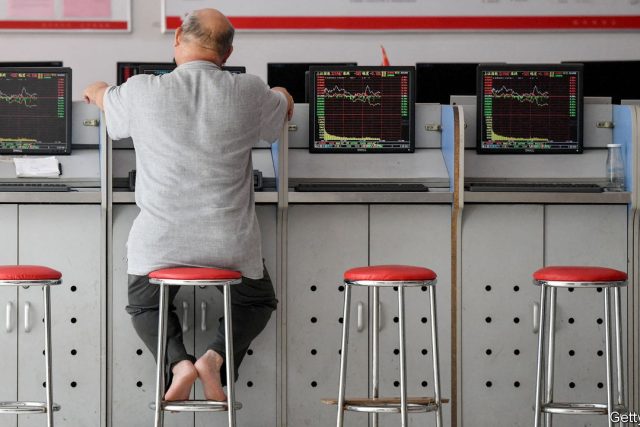Traders have an expression to describe how unpredictable financial markets can be: “better off dumb”. Stocks or other financial markets can sometimes behave in unforeseeable ways. Analysts predicted that American share prices would collapse if Donald Trump won the election in 2016—they soared. Companies that post better-than-expected earnings sometimes see their share prices decline. Glimpsing the future should give a trader an edge, and most of the time it would. But not always.
Say you knew, at the start of 2021, that inflation was going to soar, the consequence of rampant money-printing by central banks and extravagant fiscal stimulus. In addition, perhaps you also knew that inflation would then be stoked by trench warfare in Europe. With such knowledge, there is perhaps one asset above all others that you would have dumped your life savings into: the precious metal that adorns the necks and wrists of the wealthy in countries where inflation is a perennial problem.
Better off dumb, then. The price of gold has barely budged for two years. On January 1st 2021 an ounce cost just shy of $1,900. Today it costs $1,960. You would have made a princely gain of 3%.
What is going on? Working out the right price for gold is a difficult task. Gold bugs point to the metal’s historical role as the asset backing money, its use in fine jewellery, its finite supply and its physical durability as reasons to explain why it holds value. After all, at first glance the phenomenon is a strange one: in contrast to stocks and bonds, gold generates no cash flows or dividends.
Yet this lack of income also provides a clue to the metal’s mediocre returns in recent years. Because gold generates no cash flows, its price tends to be inversely correlated with real interest rates—when safe, real yields, like those generated by Treasury bonds, are high, assets that generate no cash flows become less appealing. Despite all the furore about the rise in inflation, the increase in interest rates has been even more remarkable. As a result, even as inflation shot up, long-term expectations have remained surprisingly well anchored. The ten-year Treasury yield, minus a measure of inflation expectations, has climbed from around -0.25% at the start of 2021 to 1.4% now.
In 2021 researchers at the Federal Reserve Bank of Chicago analysed the main factors behind gold prices since 1971, when America came off the gold standard, a system under which dollars could be converted into gold at a fixed price. They identified three categories: gold as protection against inflation, gold as a hedge against economic catastrophe and gold as a reflection of interest rates. They then tested the price of gold against changes in inflation expectations, attitudes to economic growth and real interest rates using annual, quarterly and daily data.
Their results indicate that all these factors do indeed affect gold prices. The metal appears to hedge against inflation and rises in price when economic circumstances are gloomy. But evidence was most robust for the effect of higher real interest rates. The negative effect was apparent regardless of the frequency of the data. Inflation may have been the clearest driver of gold prices in the 1970s, 1980s and 1990s but, the researchers noted, from 2001 onwards long-term real interest rates and views about economic growth dominated. The ways in which gold prices have moved since 2021 would appear to support their conclusion: inflation matters, but real interest rates matter most of all.
All of this means that gold might work as an inflation hedge—but inflation is not the only variable that is important. The metal will increase in price in inflationary periods if central banks are asleep at the wheel, and real rates fall, or if investors lose their faith in the ability of policymakers to get it back under control. So far neither has happened during this inflationary cycle.
A little knowledge about the future can be a dangerous thing. “The Gap in the Curtain”, a science-fiction novel by John Buchan, which was published in 1932, is a story about five people who are chosen by a scientist to take part in an experiment that will let them glimpse a year into the future. Two end up seeing their own obituaries. It is the “best investment book ever written”, according to Hugh Hendry, a Scottish hedge-fund investor, because it encourages readers to envision the future while thinking deeply about what exactly causes certain events. As the recent seemingly perplexing movements in gold suggest, unanchored future-gazing is a dangerous habit.■
Read more from Buttonwood, our columnist on financial markets:
Can anything pop the everything bubble? (Jul 4th)
Americans love American stocks. They should look overseas (Jun 26th)
Why investors can’t agree on the financial outlook (Jun 22nd)
Also: How the Buttonwood column got its name




The Most Read
Сryptocurrencies
Bitcoin and Altcoins Trading Near Make-or-Break Levels
Financial crimes
Thieves targeted crypto execs and threatened their families in wide-ranging scheme
Financial crimes
Visa Warning: Hackers Ramp Up Card Stealing Attacks At Gas Stations
News
Capitalism is having an identity crisis – but it is still the best system
Uncategorized
The 73-year-old Vietnamese refugee is responsible for bringing Sriracha to American consumers
Uncategorized
Electric Truckmaker Rivian, Backed By Amazon, Ford, Raises Whopping $1.3 Billion